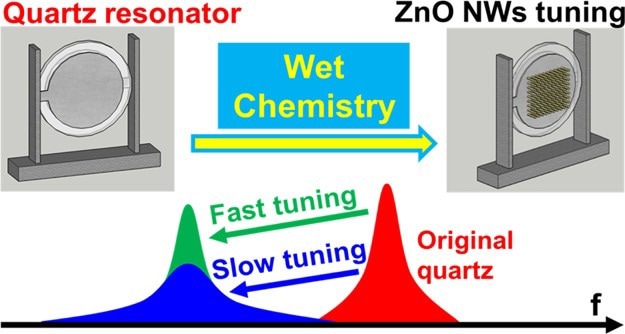Feedback is an essential mechanism in producing devices with precisely regulated attributes, allowing process parameters to be continuously modified based on real-time observations. Despite the obvious benefits of wet-chemistry approaches, applying feedback in the solution-based development of nanostructures remains largely unexplored.

Study: ZnO Nanowires for Feedback-Assisted Tuning of Electromechanical Resonators. Image Credit: Orsini, A., & Falconi, C.(2022). ACS Appl. Nano Mater.
A recent study published in the journal ACS Applied Nano Materials tackles this issue by establishing a technique for feedback-assisted tuning of low-cost electromechanical resonators using ZnO nanowire. This method enables high-accuracy post-fabrication adjustment of the resonant frequency in a simple, rapid, low-power, and low-cost way.
Feedback Mechanisms: Overview and Challenges
Feedback is a robust method for producing structures with precisely controlled attributes. It is frequently employed in micro- and nanofabrication, such as the formation of thin films, ion-beam current monitoring, and feedback-controlled electron transfer.
However, applying feedback to solution-based techniques for generating a unique nanostructure, like a nanowire, remains a challenge. Even though solution-based nanofabrication technologies offer some important benefits, such as cheap cost, broad area, and connectivity with microchips or MEMS, the attributes of solution-grown nanomaterials are often influenced by high dispersion and poor repeatability.
The feedback management of wet-chemistry nanofabrication procedures remains essentially unexplored due to the extraordinary difficulty of real-time monitoring of nanowire growth in liquids, which is necessary for "closing the loop". Moreover, the current feedback mechanisms for nanowire growth are very complicated, costly, and impractical for industrial applications.
Therefore, developing a novel and facile method for feedback-assisted tuning of solution-based nanowire growth is of extreme importance.
Importance of Electromechanical Resonators for Feedback Mechanism
Electromechanical resonators such as quartz substrates can be employed for real-time tracking and feedback-assisted control of ZnO nanowire growth due to their resonant frequency's significant dependence on the electrodes' mechanical stress.
Quartz resonators are among the most extensively utilized electromechanical resonators because of their extremely high-quality and excellent precision of the initial resonance frequencies at a reasonable cost. Quartz-based electromechanical integrators are essential in many digital systems owing to their exceptional frequency resolution, generally orders of magnitude greater than electrical RLC resonators.
The feedback-assisted control of resonant frequencies in quartz resonators can be easily realized in different applications, such as the coating of additional substances on top of the electrodes and the selective elimination of certain electrode substances.
Highlights of the Current Study
Although several nanomaterials can be formed on the electrodes of electromechanical resonators to tune their resistivity, a ZnO nanowire is unique because it can be produced on practically any substrate. Moreover, a simple galvanic-assisted process for developing a ZnO nanowire on the silver electrodes of quartz resonators has been well-established, making ZnO nanowire a promising material for feedback-control applications.
Keeping the factors above in mind, the researchers in this work deposited a ZnO nanowire on quartz electrodes using low-temperature, low-cost wet-chemistry methods to adjust the resonance frequency of electromechanical quartz resonators. They employed a single-step, galvanic-assisted, seedless approach to produce a high-density, tightly coupled ZnO nanowire on quartz resonators.
Instead of using an open-loop technique with a predetermined deposition period, real-time monitoring of the quartz absorption spectrum during nanowire growth was employed to close the feedback loop and tune the frequency response more precisely. The feedback-tuned quartz resonators were then validated using typical electronic oscillators.
Important Findings of the Research
The findings of this investigation revealed that precise adjustment of the resonance frequencies is possible with a wide frequency band. The researchers also showed that simple changes to the nutrient and reaction mechanisms during ZnO nanowire growth influence quartz quality parameters, allowing for easy control of resonator quality characteristics.
The findings demonstrated that real-time monitoring of nanowire growth might be used to create a nanowire with improved length, aspect ratio, and overall coated ZnO mass. The nanoscale size of the ZnO nanowire enabled precise resonance frequency adjustment, whilst the quartz's considerably greater diameter allowed for easy interface, handling, and packing.
Interestingly, ZnO nanowire systems are frequently used for surface acoustic wave sensors, and the method developed in this study can be applied to this significant category of electromechanical resonators. Moreover, the suggested technique may be used in other ways for manufacturing a ZnO nanowire and other quasi-1D nanomaterials.
Reference
Orsini, A., & Falconi, C. (2022). ZnO Nanowires for Feedback-Assisted Tuning of Electromechanical Resonators. ACS Applied Nano Materials. Available at: https://pubs.acs.org/doi/10.1021/acsanm.2c03963
Disclaimer: The views expressed here are those of the author expressed in their private capacity and do not necessarily represent the views of AZoM.com Limited T/A AZoNetwork the owner and operator of this website. This disclaimer forms part of the Terms and conditions of use of this website.